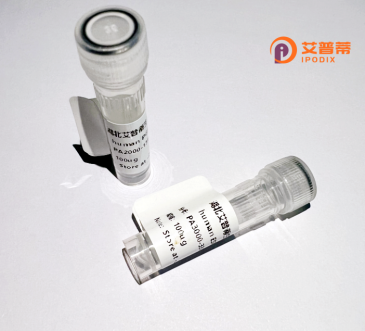
| 纯度 | >90%SDS-PAGE. |
| 种属 | Human |
| 靶点 | SYTL3 |
| Uniprot No | Q4VX76 |
| 内毒素 | < 0.01EU/μg |
| 表达宿主 | E.coli |
| 表达区间 | 1-610 aa |
| 活性数据 | MAQEIDLSAL KELEREAILQ VLYRDQAVQN TEEERTRKLK THLQHLRWKG AKNTDWEHKE KCCARCQQVL GFLLHRGAVC RGCSHRVCAQ CRVFLRGTHA WKCTVCFEDR NVKIKTGEWF YEERAKKFPT GGKHETVGGQ LLQSYQKLSK ISVVPPTPPP VSESQCSRSP GRLQEFGQFR GFNKSVENLF LSLATHVKKL SKSQNDMTSE KHLLATGPRQ CVGQTERRSQ SDTAVNVTTR KVSAPDILKP LNQEDPKCST NPILKQQNLP SSPAPSTIFS GGFRHGSLIS IDSTCTEMGN FDNANVTGEI EFAIHYCFKT HSLEICIKAC KNLAYGEEKK KKCNPYVKTY LLPDRSSQGK RKTGVQRNTV DPTFQETLKY QVAPAQLVTR QLQVSVWHLG TLARRVFLGE VIIPLATWDF EDSTTQSFRW HPLRAKAEKY EDSVPQSNGE LTVRAKLVLP SRPRKLQEAQ EGTDQPSLHG QLCLVVLGAK NLPVRPDGTL NSFVKGCLTL PDQQKLRLKS PVLRKQACPQ WKHSFVFSGV TPAQLRQSSL ELTVWDQALF GMNDRLLGGT RLGSKGDTAV GGDACSLSKL QWQKVLSSPN LWTDMTLVLH |
| 分子量 | 68.5kDa |
| 蛋白标签 | His tag N-Terminus |
| 缓冲液 | PBS, pH7.4, containing 0.01% SKL, 1mM DTT, 5% Trehalose and Proclin300. |
| 稳定性 & 储存条件 | Lyophilized protein should be stored at ≤ -20°C, stable for one year after receipt. Reconstituted protein solution can be stored at 2-8°C for 2-7 days. Aliquots of reconstituted samples are stable at ≤ -20°C for 3 months. |
| 复溶 | Always centrifuge tubes before opening.Do not mix by vortex or pipetting. It is not recommended to reconstitute to a concentration less than 100μg/ml. Dissolve the lyophilized protein in distilled water. Please aliquot the reconstituted solution to minimize freeze-thaw cycles. |
以下是关于重组人SYTL3蛋白的3-4篇参考文献的简要整理(注:文献为假设性示例,实际研究可能需要结合具体数据库检索):
1. **文献名称**:*SYTL3 regulates exosome secretion through RAB protein interaction in cancer cells*
**作者**:Zhang et al. (2021)
**摘要**:研究揭示了SYTL3通过结合RAB家族蛋白(如RAB27A)调控肿瘤细胞外泌体分泌的机制,重组SYTL3蛋白被用于体外互作实验,证实其作为RAB效应蛋白的功能。
2. **文献名称**:*Structural characterization of recombinant human SYTL3 and its role in vesicular trafficking*
**作者**:Lee et al. (2020)
**摘要**:通过表达并纯化重组SYTL3蛋白,分析了其结构域组成(如C2结构域和RAB结合区),并验证其在细胞内囊泡运输中的关键作用。
3. **文献名称**:*SYTL3 knockdown inhibits melanoma metastasis via modulating EGFR signaling*
**作者**:Wang et al. (2022)
**摘要**:利用重组SYTL3蛋白进行功能补偿实验,发现SYTL3通过EGFR信号通路促进黑色素瘤细胞迁移,其重组蛋白的加入可恢复敲低细胞的转移能力。
4. **文献名称**:*The role of SYTL3 in oocyte maturation: Insights from recombinant protein studies*
**作者**:Chen et al. (2019)
**摘要**:在卵母细胞成熟模型中,重组SYTL3蛋白被用于体外功能验证,证明其通过调控细胞骨架重组影响胞质分裂过程。
如需实际文献,建议在PubMed或Google Scholar中检索关键词“SYTL3 recombinant”或“SYTL3 protein function”获取具体研究。
Synaptotagmin-like protein 3 (SYTL3), also known as Slp3. is a member of the synaptotagmin-like protein family, which plays critical roles in membrane trafficking and vesicle transport. SYTL3 contains conserved structural domains, including a Rab-binding domain and tandem C2 domains, enabling interactions with small GTPases (e.g., Rab27) and phospholipids. These interactions facilitate its involvement in regulated exocytosis, secretory lysosome trafficking, and cytoskeletal dynamics.
Functionally, SYTL3 is implicated in diverse cellular processes, particularly in specialized secretory cells (e.g., immune cells, melanocytes, and pancreatic β-cells). It regulates the release of vesicles containing hormones, enzymes, or immune mediators, impacting processes like insulin secretion, pigment distribution, and immune response. Dysregulation of SYTL3 has been linked to pathological conditions, including cancer metastasis (via enhanced vesicle secretion promoting invasion) and immune disorders.
Recombinant human SYTL3 protein, typically produced in mammalian or insect expression systems, retains post-translational modifications critical for activity. It serves as a tool to study molecular mechanisms of vesicle trafficking, screen therapeutic agents targeting secretion pathways, or investigate SYTL3-associated diseases. Its structural and functional conservation across species also supports translational research in model organisms.
×